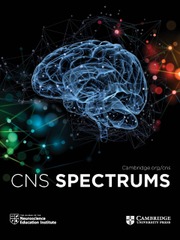Crossref Citations
This article has been cited by the following publications. This list is generated based on data provided by
Crossref.
Yuen, Kin
Davé, Ritu
and
Partinen, Markku
2004.
Sleep Deprivation.
Vol. 20042337,
Issue. ,
p.
211.
Schröder, Carmen M
and
O'Hara, Ruth
2005.
Depression and Obstructive Sleep Apnea (OSA).
Annals of General Psychiatry,
Vol. 4,
Issue. 1,
Jiang, Wei
and
Davidson, Jonathan R.T.
2005.
Antidepressant therapy in patients with ischemic heart disease.
American Heart Journal,
Vol. 150,
Issue. 5,
p.
871.
Alberti, A.
Mazzotta, G.
Gallinella, E.
and
Sarchielli, P.
2005.
Headache characteristics in obstructive sleep apnea syndrome and insomnia.
Acta Neurologica Scandinavica,
Vol. 111,
Issue. 5,
p.
309.
Schwartz, Daniel J.
Kohler, William C.
and
Karatinos, Gillian
2005.
Symptoms of Depression in Individuals With Obstructive Sleep Apnea May Be Amenable to Treatment With Continuous Positive Airway Pressure.
Chest,
Vol. 128,
Issue. 3,
p.
1304.
HOSSAIN, JAMIL L.
AHMAD, PARVEZ
REINISH, LAWRENCE W.
KAYUMOV, LEONID
HOSSAIN, NAHEED K.
and
SHAPIRO, COLIN M.
2005.
Subjective fatigue and subjective sleepiness: two independent consequences of sleep disorders?.
Journal of Sleep Research,
Vol. 14,
Issue. 3,
p.
245.
MAGLIOCCA, KELLY R.
and
HELMAN, JOSEPH I.
2005.
Obstructive sleep apnea.
The Journal of the American Dental Association,
Vol. 136,
Issue. 8,
p.
1121.
Yuen, Kin
and
Kushida, Clete
2006.
Sleep Disorders.
p.
175.
Saunamäki, T.
and
Jehkonen, M.
2007.
Depression and anxiety in obstructive sleep apnea syndrome: a review.
Acta Neurologica Scandinavica,
Vol. 116,
Issue. 5,
p.
277.
Bardwell, Wayne A.
Norman, Daniel
Ancoli-Israel, Sonia
Loredo, Jose S.
Lowery, Amy
Lim, Weonjeong
and
Dimsdale, Joel E.
2007.
Effects of 2-Week Nocturnal Oxygen Supplementation and Continuous Positive Airway Pressure Treatment on Psychological Symptoms in Patients With Obstructive Sleep Apnea: A Randomized Placebo-Controlled Study.
Behavioral Sleep Medicine,
Vol. 5,
Issue. 1,
p.
21.
Onem, Kadir
Erol, Bulent
Sanli, Oner
Kadioglu, Pinar
Yalin, Ayse S.
Canik, Uygar
Cuhadaroglu, Caglar
and
Kadioglu, Ates
2008.
Is Sexual Dysfunction in Women with Obstructive Sleep Apnea-Hypopnea Syndrome Associated with the Severity of the Disease? A Pilot Study.
The Journal of Sexual Medicine,
Vol. 5,
Issue. 11,
p.
2600.
Zhang, Jian-Hua
Fung, Simon J.
Xi, Mingchu
Sampogna, Sharon
and
Chase, Michael H.
2009.
Recurrent apnea induces neuronal apoptosis in the guinea pig forebrain.
Experimental Neurology,
Vol. 216,
Issue. 2,
p.
290.
Sjösten, Noora
Kivimäki, Mika
Oksanen, Tuula
Salo, Paula
Saaresranta, Tarja
Virtanen, Marianna
Pentti, Jaana
and
Vahtera, Jussi
2009.
Obstructive sleep apnoea syndrome as a predictor of work disability.
Respiratory Medicine,
Vol. 103,
Issue. 7,
p.
1047.
Shah, Neomi
and
Roux, Francoise
2009.
The Relationship of Obesity and Obstructive Sleep Apnea.
Clinics in Chest Medicine,
Vol. 30,
Issue. 3,
p.
455.
Madani, Mansoor
Madani, Farideh M.
and
Frank, Marcella
2010.
Psychological Issues in Sleep Apnea.
Oral and Maxillofacial Surgery Clinics of North America,
Vol. 22,
Issue. 4,
p.
503.
Habukawa, Mitsunari
Uchimura, Naohisa
Kakuma, Tatsuyuki
Yamamoto, Katsuyasu
Ogi, Kimihiro
Hiejima, Hiroshi
Tomimatsu, Kentaro
and
Matsuyama, Seiichiro
2010.
Effect of CPAP treatment on residual depressive symptoms in patients with major depression and coexisting sleep apnea: Contribution of daytime sleepiness to residual depressive symptoms.
Sleep Medicine,
Vol. 11,
Issue. 6,
p.
552.
Alam, Abdulkader
and
Chengappa, Kadiamada Nanaiah Roy
2011.
Obstructive sleep apnoea and schizophrenia: a primer for psychiatrists.
Acta Neuropsychiatrica,
Vol. 23,
Issue. 5,
p.
201.
Nair, Deepti
Dayyat, Ehab A.
Zhang, Shelley X.
Wang, Yang
Gozal, David
and
Tang, Ya-Ping
2011.
Intermittent Hypoxia-Induced Cognitive Deficits Are Mediated by NADPH Oxidase Activity in a Murine Model of Sleep Apnea.
PLoS ONE,
Vol. 6,
Issue. 5,
p.
e19847.
Alam, Abdulkader
Chengappa, K.N. Roy
and
Ghinassi, Frank
2012.
Screening for obstructive sleep apnea among individuals with severe mental illness at a primary care clinic.
General Hospital Psychiatry,
Vol. 34,
Issue. 6,
p.
660.
Krystal, Andrew D.
2012.
Psychiatric Disorders and Sleep.
Neurologic Clinics,
Vol. 30,
Issue. 4,
p.
1389.




